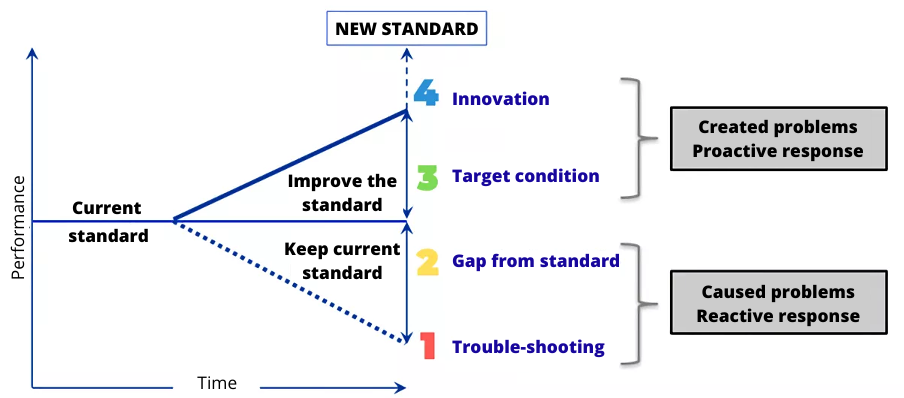Sparring about your Lean issue?
Call René.jpg)
Using data from a recent study of logistics, the author discusses how Lean Thinking contributes to a more efficient and effective way of dealing with problems.
A recent scientific study of 38 logistics flows from three different companies found that 40% of logistics workflows are wasteful. Even more frightening is the fact that this waste was not identified by employees and managers at any point during the study. However, the Lean philosophy has an explanation and solution to these problems.
It is quite common for companies to meticulously track their operating results, but the same cannot be said of processes. If there is no standard for the process, but only for the result, as long as that result is achieved (even at the expense of unknown procedures) there is nothing wrong. Indeed, paying attention only to the result without recognizing that during the process resources are consumed in a wasteful manner is a common mistake. Fortunately, there is also a range of opportunities behind it.
In the sample of processes examined, much of the waste was not seen by the teams and managers due to the lack of standards and standardized work. In all cases, the processes that were recognized by the teams were processes in which causes were sought to explain unexpected effects.
The importance of standards for work processes and outcomes is emphasized in the Lean approach to identifying and analyzing problems with the goal of improving performance. In his book Four Types of Problems, Art Smalley said it is possible to classify problems into four categories, each requiring a unique type of response.

Type 1 and 2 problems are revealed by the standard, which thus acts as a beacon for improvement. If we only have standards that are based on numeric indicators of aggregate results - numbers to be reached at the end of data collection over a series of activities - we will not be able to identify the stage at which the working standard did not perform as expected until after that aggregate measure. In this case, problems are not discovered until the end of the process, when they have already caused much waste.
This is typically when the management team calls meetings to solve these problems, looking for the causes of why the macro indicator has not been met. However, they have a very difficult time conducting this investigation and really finding the cause of the problem because there are no localized standards to pinpoint exactly where it manifests itself.
At this point, Lean Thinking reveals that at various stages of the logistics operation, we do not have clearly defined and understood standards for each procedure performed by our personnel and systems. Such standards should constitute the standardized work in which each activity is explained (how to do it, when to do it, how long it should take to do it). Everyone must recognize that there is a problem beyond these predetermined boundaries.
Problems of types 3 and 4 are of a different nature and addressing them requires a different approach. Since these problems are created rather than caused, they refer not to the fulfillment of a standard but to its elevation. Lean provides a number of management tools for this purpose, such as hoshin kanri, which is used to harness organizational strategy by turning it into actions that people throughout the company can implement. In this process, one discovers which factors and actions will lead to the desired effect.
This discovery leads to an understanding of the factors that most affect business performance and pushes the boundaries of organizational knowledge, creating ever greater leaps in performance and results. Consider this hypothetical scenario:
An organization sees the need to improve a standard: increase e-commerce sales by 50%, achieve OTIF of 98%, and NPS above 8. However, this Type-3 problem (increasing the target condition) must be preceded by an examination of the causes on which teams must act to achieve the new effect. In logistics operations, this may mean identifying what actions need to be designed and developed (causes) with new local standards to achieve the intended macro result. It also means articulating the new standards and where they should be applied.
If expanding e-commerce by 50% means, in the analysis of the expected operational impact, reducing the takt time of the logistics operation by 50%, this can lead to causal links that also point to the need to change standards in the supporting areas - such as billing, invoicing, order tracking, etc. New standards must be created to support the new standard in logistics.
Now suppose at a later stage the company needs to deliver goods to customers in a much larger area, with a superior level of service and in the same way it did for the customers it previously served in the area around the distribution center. A traditional approach of strategically located DCs will certainly not be enough to cope with the new reality, even if they become the most efficient DCs in the world.
Here we encounter a limit to our ability to improve the current standard to achieve the desired effect. Therefore, another causal factor will have to be found that can lead to faster delivery to different parts of the territory. New network design, new relationships and new communication technologies will have to be sought. In other words, the company will have to innovate. Different alternatives will appear, and using the scientific method, the company will have to search for the alternative that is most likely to produce the expected performance effect.
With this approach to identifying and solving different types of problems, finding their specific causes and the best countermeasures according to their nature, Lean Thinking can offer logistics operations and supply chains great benefits that enable them to discover new opportunities for performance improvement.
While Lean is inspired and guided by the scientific method, its application is supported by tools that do not cause difficulties or uncertainty (on the contrary, they are easily understood at all organizational levels), as evidenced by numerous practical cases around the world.


Sign up for our newsletter